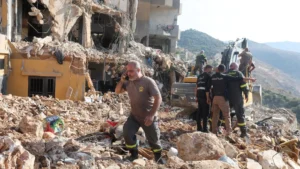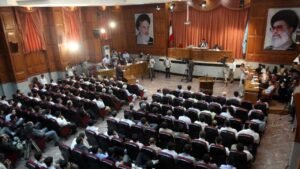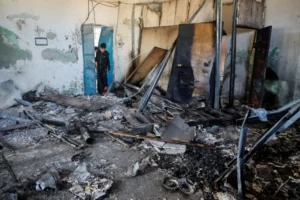Testimony of Deputy Commissioner of Intelligence and Counterterrorism Before NYC Council

TESTIMONY OF DEPUTY COMMISSIONER OF INTELLIGENCE AND COUNTERTERRORISM JOHN J. MILLER NEW YORK CITY POLICE DEPARTMENT
BEFORE THE NEW YORK CITY COUNCIL COMMITTEES ON PUBLIC SAFETY AND FIRE AND CRIMINAL JUSTICE SERVICES
NOVEMBER 12, 2014
Good afternoon, Speaker Mark-Viverito, Chairpersons Crowley and Gibson, and members of the Council. My name is John Miller, Deputy Commissioner of Intelligence and Counterterrorism at the NYPD. Today I am joined by Joseph Pfeifer, Chief of Counterterrorism and Emergency Preparedness for the Fire Department of New York (FDNY), and Calvin Drayton, First Deputy Commissioner of NYC Emergency Management. As you know, over the past 13 years, the mission of the NYPD has expanded dramatically to address the evolving threat of terrorism. On behalf of Commissioner Bratton, I am pleased to provide an overview of the current terrorism threat environment and measures that the NYPD has put in place to counter it.
More than any other place in the world, New York City remains in the crosshairs of al Qaeda and those that share its violent ideology. That is the consensus of the global intelligence community. Since September 11, 2001, there have been 18terrorist plots against New York City, targeting the New York Stock Exchange, Citigroup headquarters, the Brooklyn Bridge, John F. Kennedy Airport, Times Square, Ground Zero, the subway system, major synagogues, and other sites, and most recently, NYPD personnel. But so far, they have been thwarted at nearly every turn by the efforts of the NYPD and our local andfederal partners. We have been able to build a deterrent that has kept this city safe while protecting and upholding the constitutional rights and liberties accorded to those who live, work, and visit New York City.
September 11th forever changed how the NYPD views its mission and the world around us. Building upon efforts first launched during the previous administration, we continue to prioritize this ever-evolving menace. To its credit, the previous administration recognized that we could not defer this responsibility to others and set about reorganizing the Department accordingly.
Soon after 2001, the NYPD became the first police department in the country to develop its own robust counterterrorism capacity. We established a division responsible for training and equipping every one of our police officers for counterterrorism duties. We charged our intelligence operations with a new, international focus. While Intelligence and Counterterrorism Bureau personnel continue to coordinate and support the protection of diplomats and world leaders – most recently during the United Nations General Assembly in September – ourmission now includes gathering and analyzing intelligence with global implications.
Our commitment to ensuring that sufficient resources are dedicated to this critical mission has not changed. Since 2002, the Department has been awarded $1.4 billion in federal counterterrorism funds, which have been used for mission-critical equipment, training, and salaries, which I will discuss later in my testimony.
One of our premier resources is our personnel. Over the years, the caliber of people we have been able to attract has played a major role in our ability to protect New York.
We have hired civilian intelligence analysts who are experts in intelligence and foreign affairs. They study terrorist groups, trends, and methods of attack.
We have assigned police officers to serve as liaisons in 11 cities around the world: London, Madrid, Paris, Tel Aviv, Abu Dhabi, Amman, Lyon, Montreal, Toronto, Singapore, and Santo Domingo. From these locations, and in coordination with our federal and international partners, our liaisons can travel to the scenes of terrorist attacks that occur throughout Europe, the Middle East, and Asia to help analyze the specific tactics used, the type of weaponry and explosives involved, where the planning was conducted, and the nature of the targets – all to better learn how best to defend New York City against a similar attack.
This investment has paid dividends. In response to the 2012 deadly bus attack at the airport in Bulgaria, our liaison officer stationed in Tel Aviv was able to supply us with critical information on the tactics used by the attackers. Last year, our detectives also deployed to the scene of the Westgate Mall in Kenya following the heinous attack by al Qaeda’s Somalia-based affiliate al-Shabaab. NYPD uses the information gathered from such assignments to adapt its tactics, techniques, and procedures to deter and/or thwart potential similar attacks in New York City.
One of our most important institutional strengths is the remarkable diversity in our ranks. The NYPD is fortunate to have a deep pool of foreign language–speaking officers. This has allowed us to build a foreign linguist program with more than 1,200 registered speakers of 85 different languages – Arabic, Dari, Farsi, Mandarin, Pashto, Russian, Spanish, and Urdu, to name just a few.
Our diversity has bolstered every aspect of our mission, from counterterrorism to crime-fighting to community relations. Through our Community Affairs Bureau, we have assigned liaisons to the Arab and Muslim, Chinese, Eastern European, Hispanic, and West African communities. They help connect immigrants to needed services and build stronger connections between police and community.
The department strongly believes that the vigilance of all New Yorkers serves as a force multiplier in keeping the city safe. We established New York City Safe, a terrorism threat hotline, where concerned citizens could report suspicious activity. I assure you that we take all leads seriously, and follow up on them diligently and calibrated to the facts and circumstances of the particular lead.
Toward the goal of continually improving trust with communities most affected by the issues of terrorism, we regularly meet with religious leaders to discuss potential threats, concerning trends, or fears that their communities may share. In conjunction with the Department of Homeland Security and the National Counter Terrorism Center, the NYPD hosted a Countering Violent Extremism exercise to foster partnership and mutual understanding. The event, held in September 2014, was the first of what we hope are many in a new initiative to partner with local groups to bring police and community together in security and assurance.
In addition to our community outreach efforts, we also coordinate closely with outside partners, including the federal government, regional law enforcement agencies, and the private sector.
One of the most vital of these partnerships is with the Joint Terrorism Task Force, or JTTF. We work hand in glove with the JTTF, sharing information and following up on terrorism-relatedleads.
Our collaborative efforts include assigning personnel to other federal agencies. These include the Drug Enforcement Administration’s Special Operations Division, the High Intensity Drug Trafficking Area Task Force, the National Intelligence Council, and U.S. Customs and Border Protection.
We also share information with more than 150 law enforcement agencies throughout the Northeast and Mid-Atlantic in a program called Operation Sentry. We do this knowing that it is often easier for terrorists to develop a plot outside the target area. We took note that the suicide bombers that struck the London transit system in 2005 built their bombs in the city of Leeds, 180 miles north of the target. Closer to home, the plan to bomb the World Trade Center in 1993 was hatched across the Hudson River, in New Jersey. And Faisal Shahzad, who attempted to detonate a car bomb in Times Square in 2010, assembled his explosives in Connecticut. We conduct various types of training with our Sentry partners, hold video-conferences on emerging threats, and exchange best practices with respect to terrorist and traditional crime matters.
Following the London transit attacks in 2005, the NYPD convened the Amtrak Security Coalition, a public-sector partnership made up of law enforcement agencies along Amtrak’s Northeast Corridor. The purpose of the Coalition is to bolster security and improve cooperation along the rail route, which is one of the most sensitive and heavily-traveled in the nation. We know transit systems nationwide are a vulnerable target, and in New York City they have been a target on more than one occasion. In September 2009, former Queens resident Najibullah Zazi and two of his friends plotted to conduct a multiple suicide attack on the New York City subways. In 2008, former Long Island resident Bryant Neal Vinas spoke tomembers of al Qaeda about how to target the Long Island Railroad for an attack. The Herald Square subway station and the PATH train have also been targets in foiled terrorism plots.
In an unprecedented initiative supported by the Department of Homeland Security, we have installed radiation detection equipment throughout neighboring jurisdictions and at key points of entry into the five boroughs so that the city is virtually ringed with an alarm system. This program, called Securing the Cities, includes 150 law enforcement agencies in dozens of nearby cities and towns. The NYPD is responsible for distributing all of the radiation detectors used by our partners.
When it comes to the private sector, we collaborate with nearly 13,000 members of the region’s private security industry through a program called NYPD Shield. The membership consists of security professionals tasked with protecting critical infrastructure and sensitive buildings in the New York metropolitan area. Through the Shield program, we regularly host conferences, sector specific briefings, and training seminars as well as share NYPD strategic assessments on terror trends. Under another initiative, Operation Nexus, our detectives have made over 55,000 visits to businesses that make, sell, or inventory products, services, or materials that might be exploited by terrorists, such as truck rental outfits, fertilizer stores, and chemical supply companies. We ask them to contact us if they see anything unusual, anything that gives them pause.
We also partner with the private sector to secure areas of the city known to be terrorist focal points. We do this through our Domain Awareness System (DAS), a centralized network of security cameras, license plate readers, and chemical and radiological detectors. Using an advanced graphical interface and mapping capability, the DAS is able to retrieve and display information to provide real-time alerts and the means to quickly call up relevant information to guide police action. This makes it possible for us to scan recorded footage for specific objects and behaviors. We can also program the system to alert us to potentially suspicious scenarios: a bag left unattended; a car driving against the flow of traffic, or a person walking through a restricted area. The program is continuously expanding and currently receives data from more than 6,600 cameras, nearly 500 license plate readers, and scores of strategically-placed chemical and radiation detectors throughout the city, which provide instant alerts on possible threats in the city.
Across the city, we have distributed approximately 3,000 radiation pagers to units throughout the department and nearly 4,000 radiological dosimeters to each Patrol Borough’s counterterrorism trailer. We continue to invest heavily in acquiring and maintaining state-of-the-art equipment to identify, prevent, or disrupt threats. From sonar systems to thermal imaging cameras, we have installed highly sensitive detection equipment on the boats and helicopters we use to patrol New York Harbor. Police vehicles are also outfitted with similar detection capabilities.
Equipment accounts for over $920.5 million of federal counterterrorism funds since 2002. Beyond equipment for the Domain Awareness System and explosive and radiological detection, these funds helped us purchase communications equipment for the World Trade Center; personal protective equipment; fixed wing aircraft, helicopters, vehicles, and boats for emergency response and rescue; and computer systems for intelligence gathering, network security, and disaster recovery.
We are also constantly looking to disrupt any budding plots. Every day, through Operation Hercules, we deploy teams of heavily armed officers to make unannounced visits to iconic locations. We stage multiple Critical Response Vehicle deployments throughout the day of up to 100 patrol cars that proceed in formation, lights flashing, to prearranged locations. We have similar units that focus on ferry terminals, regional transport lines, and the subways.
We place particular emphasis on the subway system in light of its primacy as a target and because it is a vital artery that keeps this city running. In excess of five million New Yorkers use the subways every day. Protecting this system is one of our top priorities and greatest challenges. That is because the entire system is designed to be open, 24 hours a day, every day of the year. Its very strengths as mass transit leave it vulnerable to attack. After the bombing of the London transit system in 2005, we began screening the bags and backpacks of subway passengers. Every day, we maintain posts at each of the 14 underwater subway tunnels. Thanks to a federal grant, we were able to hire over 100 police officers for our Transit Impact Program and re-assign an equal number of veteran officers to our transit-based Anti-Terrorism Unit. They conduct mobile screenings, transit order maintenance sweeps, surges, and counter-surveillance. We have heightened uniformed patrols underground and conduct regular security sweeps of subway cars.
The salaries and overtime for all of the specialized counterterrorism teams described above, including those for detectives and analysts in the Intelligence Bureau and on the Joint Terrorism Task Force, accounted for $423.2 million of the federal funds allocated to NYPD since 2002.
We also prioritize counterterrorism training. Since 2002, we have dedicated $101.7 million of federal counterterrorism funds totraining programs, including Behavioral Observation and Suspicious Activity Recognition; Hostile Surveillance Detection; Initial Law Enforcement Response to Suicide Bomber Attacks; Advanced Explosive Trace Detection; Awareness and Response to Biological Events; Chemical Ordinance, Biological and Radiological Awareness Training; and Maritime Incident Response Team Training.
The Department conducts and participates with other New York City and government agencies in counterterrorism exercises including tabletop, functional, and full-scale (i.e. “boots on the ground”) drills. For example, the Department hosts Executive Tabletop Exercises that includes senior leaders from various City and government agencies (e.g. FDNY, NYC Emergency Management, NYC Department of Health and Mental Hygiene, Con Edison, and the Metropolitan Transportation Authority).
In addition, the NYPD participates in full-scale exercises conducted by NYC Emergency Management. The most recent exercise was conducted last November and was based on a scenario involving the detonation of a radiological dispersal device at Coney Island’s MCU Park in Brooklyn. In addition to NYPD, this exercise included the operational response of members of FDNY, NYC Department of Environmental Protection, and the NYC Department of Health and Mental Hygiene to the initial response phase of the incident.
The Department has taken part in dozens of major exercises to plan for and safeguard against chemical, biological, radiological, or nuclear attacks, in addition to another dozen workshops with our Securing the Cities regional partners. Utilizing lessons learned from previous terror attacks, including those garnered from our liaisons abroad, the Department holds regular exercises to examine potential threat scenarios and capabilities that will be required to successfully respond to and mitigate the threat.
In addition to those mentioned above, in the past year we have held active shooter exercises, simulated IED attacks, stagedvarious attack scenarios at high-profile events; and conducted exercises involving dirty bomb detonations at subway stations and platforms. These exercises inform our special event planning and response. For example, based on lessons learned the Department may deploy physical security measures such as temporary barriers; Critical Response Vehicles; heavy weapons teams; canine assets; bag screening; explosive trace detection; hostile surveillance detection; or radiation detection.
These are some of the tools we are using to keep pace with the evolving threat of terrorism. The philosophy behind them is simple: we have to develop the best intelligence available, expand our partnerships, and take protective measures to defeat whatever our adversaries might be planning next.
Unfortunately, our adversaries have multiplied in recent years. What was once the domain of only a few, top-down groups operating from the safe havens of failed or hostile spaces has over time devolved into regional affiliates and local upstarts dispersed across the globe, as well as entrepreneurial lone-wolves within our shores dedicated to actualizing our adversaries’ goals.
In 2014 alone, there have been multiple calls for violence against New York City. The 12th issue of Inspire, the prominent English-language magazine of al-Qaeda’s Yemen-based affiliate, al-Qaeda in the Arabian Peninsula, urged lone-wolf car bomb attacks in U.S. cities, while specifically mentioning the Queens-based U.S. Open as a desirable target. There are also reports that al-Qaeda operatives in Syria and Iraq have continued to plot against the homeland. And in September 2014, members of aweb forum belonging to former al-Qaeda affiliate and now rival the Islamic State of Iraq and al–Sham, or ISIS, posted a call for supporters to attack Times Square complete with bomb-making instructions to help them do it.
In addition to monitoring potential threats from abroad, we have to be concerned about threats originating at home. Last month we witnessed a horrifying terrorist attack on two police officers by a Queens man who charged at them with a hatchet. The attacker’s internet activity suggests that he sought to “terrorize” the Police Department and focused on “jihad” against the police and the United States. The quick response by their fellow officers enabled them to both eliminate the threat and tend to their wounded colleagues. We are fortunate that both Officer Kenneth Healey and Officer Joseph Meeker survived and hope for Officer Healey’s speedy recovery.
In the past year alone, NYPD and its federal partners have arrested and successfully prosecuted several homegrown violent extremists who desired to join or support those who would kill Americans. Two young men from Long Island, Justin Kaliebe and Ali Zea, plotted to travel to Yemen to join al-Qaeda in the Arabian Peninsula. They were arrested and later pleaded guilty to federal terrorism charges. Both await sentencing. Two other men, Humayoun Nabi and Ismail Alsarabi, were arrested on New York state-level terrorism charges for seeking to send cold weather gear and electronics to support terrorist organizations in Afghanistan and Pakistan. Both defendants pleaded guilty, marking the first ever state-level material support charge successfully applied in New York State.
Abdel Hameed Shehadeh, who plotted to join the U.S. Army for an opportunity to kill fellow American service members, and when that failed, to join the Taliban, was sentenced to 13 years in prison for making false statements in a matter involving international terrorism. Jose Pimentel was sentenced to 16 years in prison for constructing three IEDs intended for use against U.S. military personnel and civilians. And Yousef al-Khattab, who urged assaults on Jews and Jewish organizations in New York City via the internet, was sentenced to 2.5 years in federal prison after pleading guilty to using the Internet to place others in fear of serious bodily injury. To date, NYPD suspects arrested on terrorism-related charges have been convicted at an extraordinarily high rate.
The threat posed by Americans traveling to join militant groups abroad in order to gain military and terrorist training has metastasized in the wake of the Syrian civil war which is now in its fourth year. The CIA estimates that 12,000 foreigners and at least 100 Americans have traveled to Syria to join militant groups, including ISIS. Given the chaos and fluidity of the situation in Syria, where individual fighters and entire groups change affiliation with regularity, we remain concerned with all New Yorkers who take steps to fight in Syria. Already the story of one New Yorker who traveled to Syria to join a militant group was cited in the media. An investigation into a Brooklyn resident who trained with a militant group in Syria led investigators to uncover an unrelated international drug ring and resulted in the arrest of 16 individuals across four states for the illegal importation and distribution of khat. Three of those individuals now face prison terms of up to 25 years.
Of course, while conducting our sensitive counterterrorism operations, the value we place on privacy rights and other constitutional protections is foremost on our minds. The protection of civil liberties is as important to the Police Department as the protection of the city itself. After all, it is these very freedoms that we seek to defend against our adversaries. Our terrorism-related investigations are treated with particular care because we recognize that they may, at times, implicate the First Amendment and other important issues. Accordingly, we abide not only by the U.S. Constitution and other applicable law, but also a federal consent decree that imposes additional checks on our counterterrorism investigations to ensure that the Police Department appropriately balances security concerns with our need to protect civil liberties.
A decade after 9/11, New York enjoys the distinction of being the safest big city in America. It is also commercially vibrant, culturally diverse, and free. We can claim these successes aredue, in no small measure, to the 50,000 uniformed and civilian members of the New York City Police Department, in cooperation with the FDNY, NYC Emergency Management and other partners, who have demonstrated initiative and perseverance in face of varied and persistent threats.
Thank you again for this opportunity to testify. I would be happy to answer any of your questions.





